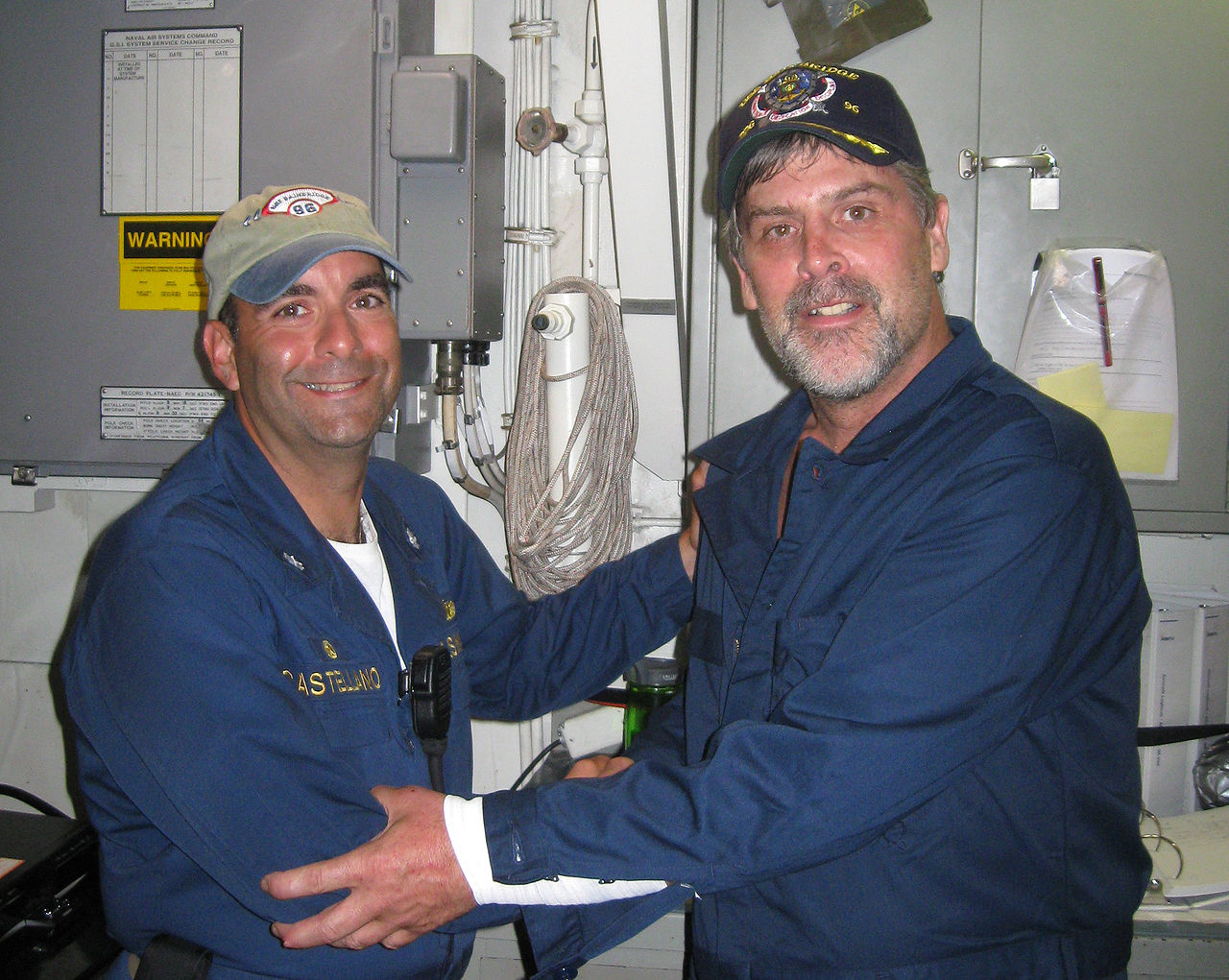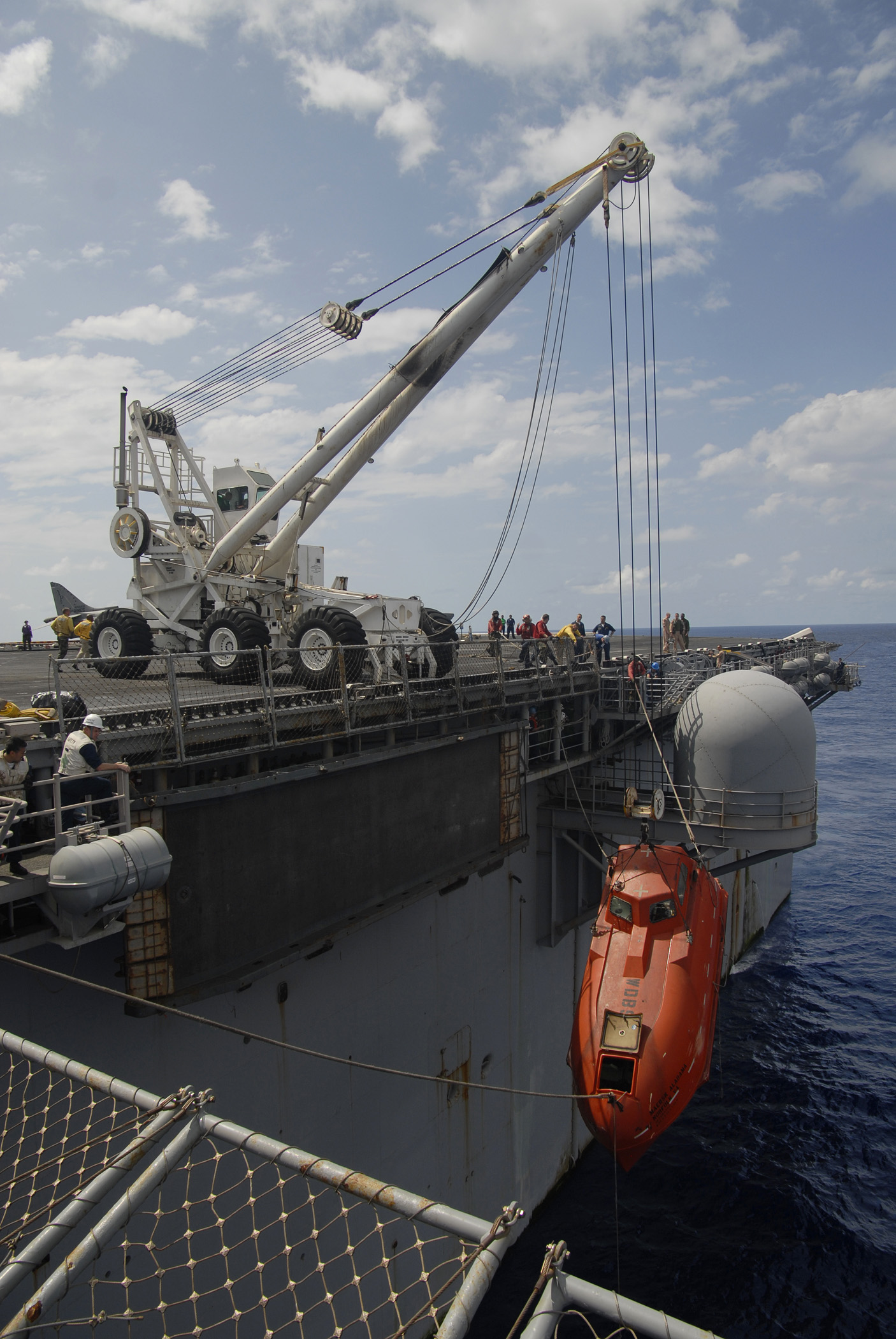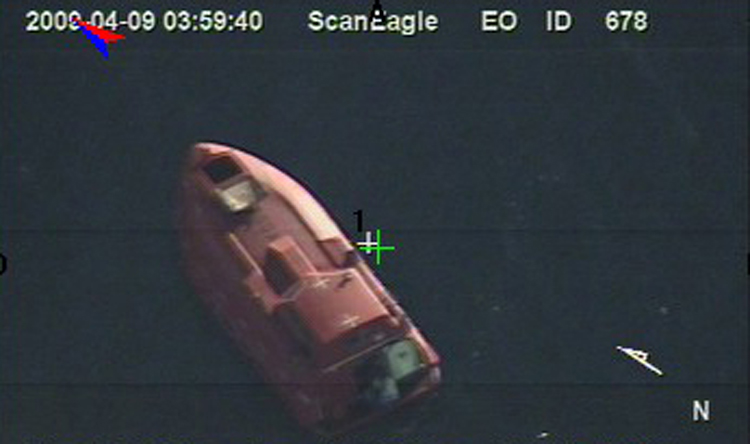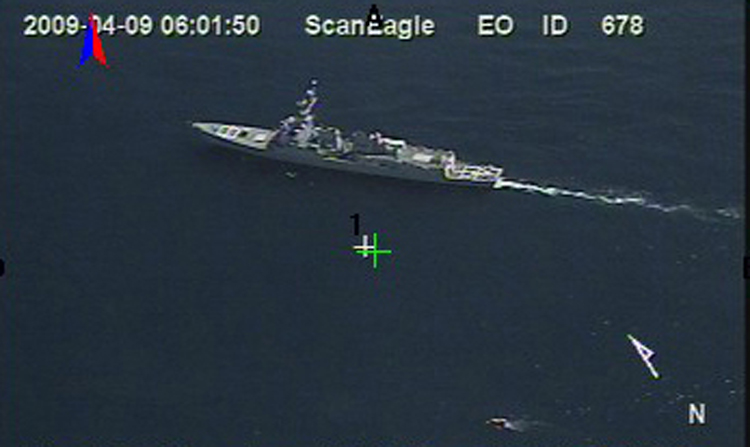Maersk Alabama hijacking
| The below content is licensed according to Creative Commons Attribution-ShareAlike License contrary to the public domain logo at the foot of the page. It originally appeared on http://en.wikipedia.org. The original article might still be accessible here. You may be able to find a list of the article's previous contributors on the talk page. |
The Maersk Alabama hijacking was a series of events involving piracy that began with four Somali pirates seizing the cargo ship Maersk Alabama 240 nautical miles southeast of the Somali port city of Eyl. This event ended after a rescue effort by the U.S. Navy on 12 April 2009.[1] It was the first successful pirate seizure of a ship registered under the American flag since the early 19th century.[2] It was the sixth vessel in a week to be attacked by pirates who had previously extorted ransoms in the tens of millions of dollars.
Contents
Timeline of events
Hijacking
The ship, with a crew of 20, loaded with 17,000 metric tons of cargo, was bound for Mombasa, Kenya. On 8 April 2009, four pirates based on the FV Win Far 161 attacked the ship.[3][4][5] All four of the pirates were between 17 and 19 years old, according to U.S. Secretary of Defense Robert Gates.[6]
The crew members of the Alabama had received anti-piracy training from union training schools, and had drilled aboard the ship a day previously. Their training included the use of small arms, anti-terror, basic safety, first aid, and other security-related courses.[7][8] When the pirate alarm sounded early on Wednesday, 8 April, Chief Engineer Mike Perry brought 14 members of the crew into a "secure room" that the engineers had been in the process of fortifying for just such a purpose. As the pirates approached, the remaining crew fired flares; in addition, Perry and 1st A/E Matt Fisher swung the ship's rudder, which swamped the pirate skiff.[9]
Nonetheless, the ship was boarded. Perry initially had taken main engine control away from the bridge and 1st A/E Matt Fisher had taken control of the steering gear. Perry then shut down all ship systems and the entire vessel "went black." The pirates captured Capt. Richard Phillips and several other crew members minutes after boarding, but soon found that they could not control the ship.
Perry remained outside the secure room lying in wait, knife in hand, for a visit from the pirates who were trying to locate the missing crew members in order to gain control of the ship and presumably sail it to Somalia. Perry tackled the ringleader of the pirates and took him prisoner after a cat-and-mouse chase in a darkened engine room. The seamen on watch at the time stabbed one pirate in the hand.[9]
The crew attempted to exchange the pirate they had captured[10] for the captain, but the exchange went awry and after the crew released their captive, the pirates refused to honor the agreement. Phillips escorted the pirates to a lifeboat to show them how to operate it where they fled with the Captain.[11]
On 8 April 2009, the destroyer USS Bainbridge was dispatched to the Gulf of Aden in response to the hostage situation, and reached the Maersk Alabama early on 9 April.[12]
The Alabama was then escorted from the scene under armed guard towards its original destination of Mombasa where Captain Larry D. Aasheim retook command of the ship. Phillips had relieved Aasheim nine days earlier.[citation needed] CNN and Fox News quoted sources stating that the pirates' strategy was to await the arrival of additional hijacked vessels carrying more pirates and additional hostages to use as human shields.[13][14]
Rescue
A stand-off ensued between the USS Bainbridge, USS Haliburton and the pirates' lifeboat from the Maersk Alabama from 9 April 2009, where they held the captain of the ship, Richard Phillips, hostage. The lifeboat itself was covered and contained plenty of food and water but lacked basic comforts, including a toilet or ventilation.[15] The Bainbridge was equipped with ScanEagle and lifeboats. The USS Halyburton held two SH-60B helicopters on board. Both vessels stayed several hundred yards away, out of the pirates' range of fire. A P-3 Orion surveillance aircraft secured aerial footage and reconnaissance. Radio communication between the two ships was established. Four foreign vessels held by pirates headed towards the lifeboat. A total of 54 hostages were on two of the ships, citizens of China, Germany, Russia, the Philippines, Tuvalu, Indonesia and Taiwan.[16][17]
On 10 April 2009, Phillips attempted to escape from the lifeboat but was recaptured after the captors fired shots. The pirates then threw a phone – and a two-way radio dropped to them by the U.S. Navy – into the ocean, fearing the Americans were somehow using the equipment to give instructions to the captain. The U.S. dispatched another warship, amphibious assault ship USS Boxer, to the site off the Horn of Africa. The pirates' strategy was to link up with their comrades, who were holding various other hostages, and to get Phillips to Somalia where they could hide him and make a rescue more difficult for the Americans. Anchoring near shore would allow them to land quickly if attacked. Negotiations were ongoing between the pirates and the captain of the Bainbridge, who was under the direction of FBI hostage negotiators. The captors were also communicating with other pirate vessels by satellite phone.[16]
However, negotiations broke down hours after the pirates fired on the USS Halyburton not long after sunrise on Saturday. The American frigate did not return fire and "did not want to escalate the situation". No crew members of the USS Halyburton were injured from the gunfire, as the shots were fired haphazardly by a pirate from the front hatch of the lifeboat. Videos of the shooting incident filmed by the USS Halyburton's shipboard intelligence team have been shown in documentaries of the hijacking that were broadcast on the Discovery Channel and History.[18]
"We are safe and we are not afraid of the Americans. We will defend ourselves if attacked", one of the pirates told Reuters by satellite phone. Phillips' family had gathered at his farmhouse in Vermont awaiting a resolution to the situation.[19]

On Saturday, 11 April 2009, the Maersk Alabama arrived in the port of Mombasa, Kenya under U.S. military escort. An 18-man security team was on board.[12] The FBI then secured the ship as a crime scene.[20]
Commander Castellano stated that as the winds picked up, tensions rose among the pirates and "we calmed them" and persuaded the pirates to be towed by the Bainbridge.[21]
On Sunday, April 12, Navy marksmen opened fire and killed the three pirates on the lifeboat, and Phillips was rescued in good condition.[22][23] The Bainbridge captain Commander Frank Castellano, with prior authorization from U.S. President Barack Obama, ordered the action after determining Phillips' life was in immediate danger, citing reports that a pirate was pointing an AK-47 assault rifle at Phillips' back.[24][25][26] Navy SEAL snipers on Bainbridge's fantail had opened fire nearly simultaneously, killing the three pirates with bullets to the head.[27][28] The SEALs had arrived Friday afternoon after being parachuted into the water near the Halyburton, which later joined with the Bainbridge.[9] At the time, the Bainbridge had the lifeboat under tow, approximately 25 to 30 yards astern.[29] One of the pirates killed was named Ali Aden Elmi, the last name of another was Hamac, and the third has not been identified in English-language press reports.[30] A fourth pirate, Abduwali Abdukhadir Muse, aboard the Bainbridge and negotiating for Phillips release while being treated for an injury sustained in the takeover of Maersk Alabama, surrendered and was taken into custody.
The bodies of the three dead pirates were turned over by the U.S. Navy to unidentified recipients in Somalia in the last week of April 2009.[31]
Trial
The surviving pirate Abduwali Abdukhadir Muse, was flown to the U.S. for trial. In a federal courtroom in New York City, prosecutors brought charges that included piracy, conspiracy to seize a ship by force, and conspiracy to commit hostage-taking.[32] Muse's lawyers asked that he be tried as a juvenile, alleging he was either 15 or 16 years old at the time of the hostage taking, but the court ruled Muse was not a juvenile and would be tried as an adult.[33][34] Muse later pled guilty to piracy charges and was handed a prison sentence of 33 years and nine months.[35][36]
Lawsuit
On 27 April 2009, Maersk Alabama crew member Richard E. Hicks filed a lawsuit against his employer, Waterman Steamship Corporation and Maersk Line, Ltd., for knowingly sending him into pirate-infested waters near Somalia. Houston attorney Terry Bryant, who is representing Richard Hicks, said the ship owners knowingly exposed their employees to imminent danger and took no steps to provide appropriate levels of security and safety for their employees.[37]
Lifeboat on display
The owners of U.S. Maersk Alabama donated the bullet-marked 5-ton fiberglass lifeboat upon which the pirates held Captain Phillips hostage to the National Navy UDT-SEAL Museum in Fort Pierce, Florida, in August 2009.[38][39] The lifeboat had recently been on loan to National Geographic for its "Real Pirates" exhibition at the Nauticus marine science museum in Norfolk, Virginia.[40]
Also on display at the Museum is a Mark 11 Mod 0 (SR-25) sniper rifle of the type used by the U.S. Navy SEALS to kill the pirates and free Phillips.
See also
- List of ships attacked by Somali pirates
- List of ships held by Somali pirates
- Combined Task Force 150 and Combined Task Force 151, coalition force counter-piracy operations in the region.
- Dai Hong Dan, a similar incident involving the hijacking of a North Korean ship.
- Joint Special Operations Command
- Operation Atalanta a campaign of the European Union to stop the piracy off the Somali coast.
- Operation Dawn 9: Gulf of Aden, a naval operation of the Royal Malaysian Navy to rescue Malaysian flagged-tanker.
- Operation Dawn of Gulf of Aden, a similar rescue of a South Korean-operated tanker.
- Piracy in Somalia
- Second Barbary War
Notes
- ↑ Sanders, Edmund; Barnes, Julian E. (9 April 2009). "Somalia pirates hold U.S. captain". Los Angeles Times. http://articles.latimes.com/2009/apr/09/world/fg-somali-pirates9. Retrieved 12 April 2009.
- ↑
Many news reports referenced the last pirate seizure as being during the Second Barbary War in 1815; however, other incidents had occurred as late as 1821. See:
- McShane, Larry (8 April 2009). "Americans take back cargo ship Maersk Alabama after it was hijacked by Somali pirates". New York Daily News. http://www.nydailynews.com/news/us_world/2009/04/08/2009-04-08_somali_pirates_seize_usflagged_cargo_ship_with_21_american_sailors_says_diplomat.html. Retrieved 8 April 2009.
- Davis, William (2 May 2005). The pirates Laffite. Houghton Mifflin Harcourt. p. 457. ISBN 978-0-15-100403-4. http://books.google.com/books?id=q6HmmXy-wkUC&pg=PA457&dq=pirates+american+ship#PPA457,M1.
- Porter, David (1875). Memoir of Commodore David Porter. p. 291. http://books.google.com/?id=fCRCAAAAIAAJ&pg=RA2-PA288&dq=pirates+david+porter#PPP4,M1.
- ↑ Huang-chih, Chiang (7 September 2009). "Does the Ministry of Foreign Affairs care about ‘Win Far’?". Taipei Times. http://www.taipeitimes.com/News/editorials/archives/2009/09/07/2003452966.
- ↑ "Somali pirates hijack Danish ship". BBC news. 8 April 2009. http://news.bbc.co.uk/2/hi/africa/7989474.stm. Retrieved 8 April 2009.
- ↑ "Ship carrying 20 Americans believed hijacked off Somalia". CNN. 9 April 2009. http://www.cnn.com/2009/WORLD/africa/04/08/ship.hijacked/index.html. Retrieved 9 April 2009.
- ↑ "Somalian pirate suspect arrives in New York to be tried in U.S. court". CBC News. 20 April 2009. http://www.cbc.ca/news/world/story/2009/04/20/us-somaliapirate.html. Retrieved 12 August 2013.
- ↑ Another Miracle Brought to You By America's Unions (This Time With Pirates!) | Mother Jones
- ↑ AFL-CIO NOW BLOG | Union Crew Avoids Pirate Takeover, But Ship’s Captain Held Hostage
- ↑ 9.0 9.1 9.2 Cummins, Chip; Childress, Sarah (16 April 2009). "On the Maersk: 'I Hope if I Die, I Die a Brave Person'". The Wall Street Journal. http://online.wsj.com/article/SB123984674935223605.html. Retrieved 16 April 2009.
- ↑ "Africa , FBI in hostage talks with Somalis". BBC News. 9 April 2009. http://news.bbc.co.uk/2/hi/africa/7991114.stm. Retrieved 9 April 2009.
- ↑ "Cargo ship heads for Kenya". CNN. 8 April 2009. http://www.cnn.com/2009/WORLD/africa/04/09/ship.hijacked/index.html. Retrieved 9 April 2009.
- ↑ 12.0 12.1 "U.S. Warship Shadows Somali Pirates With Hostage". Associated Press. 9 April 2009. http://www.npr.org/templates/story/story.php?storyId=102902163. Retrieved 12 April 2009.
- ↑ McKenzie, David (10 April 2009). "Pirates raising the stakes". CNN. http://ac360.blogs.cnn.com/2009/04/10/pirates-raising-the-stakes/. Retrieved 12 April 2009.
- ↑ "14 ships, 260 crew held by Somali pirates". Associated Press. Fox News. 8 April 2009. http://www.foxnews.com/wires/2009Apr08/0,4670,PiracyHijackingsGlance,00.html. Retrieved 12 April 2009.
- ↑ [[Rebecca Roberts |Roberts, Rebecca]] (11 April 2009). "Mariner Details Life Aboard A Lifeboat". NPR. http://www.npr.org/templates/story/story.php?storyId=103001414.
- ↑ 16.0 16.1 Houreld, Katharine; Muhumed, Malkhadir M. (10 April 2009). "Pirates recapture US hostage after escape attempt". Associated Press. http://www.breitbart.com/article.php?id=D97FNAS80&show_article=1. Retrieved 12 April 2009.
- ↑ "Pirates Hold American Captain Hostage; Negotiations Continue for Release". The NewsHour with Jim Lehrer. 9 April 2009. http://www.pbs.org/newshour/updates/africa/jan-june09/somalia_04-09.html. Retrieved 12 April 2009.
- ↑ Serge F. Kovaleski, Mark Mazzetti; Liz Robbins (11 April 2009). "Negotiations Break Down in Standoff With Pirates". The New York Times. http://www.nytimes.com/2009/04/12/world/africa/12somalia.html?_r=1. Retrieved 12 April 2009.
- ↑ Rice, Xan; Weaver, Matthew (10 April 2009). "Somali pirates vow to take on US military might if attacked". Guardian (London). http://www.guardian.co.uk/world/2009/apr/10/somali-pirates-hostage-us-miltary. Retrieved 12 April 2009.
- ↑ Gaskell, Stephanie (12 April 2009). "WRAPUP 10-U.S. Navy rescues captain, kills Somali pirates". Reuters. New York: Thomson Reuters. http://www.nydailynews.com/news/us_world/2009/04/14/2009-04-14_seals_freed_phillips_with_simultaneous_shots.html. Retrieved http://www.reuters.com/article/marketsNews/idUSN1134689120090412?pageNumber=2&virtualBrandChannel=10112.
- ↑ "Commander Castellano interviewed by Brian Williams on NBC Nightly News". MSNBC. http://www.msnbc.msn.com/id/22425001/vp/30196489#30196489. Retrieved 14 April 2009.
- ↑ Hostage captain rescued; Navy snipers kill 3 pirates CNN, April 12, 2009
- ↑ "US captain rescued from pirates". BBC News. April 13, 2009. http://news.bbc.co.uk/2/hi/africa/7996087.stm. Retrieved April 13, 2009.
- ↑ "Official: US sea captain faced imminent danger". Associated Press. April 12, 2009. http://www.google.com/hostednews/ap/article/ALeqM5gSXyAok3YrJTZLKD31SAjC9pfvkgD97H4J581. Retrieved April 12, 2009.
- ↑ Mikkelsen, Randall (April 12, 2009). "US acted after pirates aimed at ship captain". Reuters. Archived from the original on April 14, 2009. http://www.webcitation.org/5g1mfPfQu. Retrieved April 12, 2009.
- ↑ "US captain rescued from pirates". BBC News. April 13, 2009. http://news.bbc.co.uk/2/hi/africa/7996087.stm. Retrieved April 13, 2009.
- ↑ Hostage captain rescued; Navy snipers kill 3 pirates CNN, April 12, 2009
- ↑ Gaskell, Stephanie (14 April 2009). "Three Navy SEALS freed Capt. Phillips from pirates with simultaneous shots from 100 feet away". New York Daily News. http://www.nydailynews.com/news/us_world/2009/04/14/2009-04-14_seals_freed_phillips_with_simultaneous_shots.html. Retrieved 16 April 2009.
- ↑ McCrummen, Stephanie; Tyson, Ann Scott (12 April 2009). "U.S. Ship Captain Rescued From Pirates by Navy Seals". The Washington Post. http://www.washingtonpost.com/wp-dyn/content/article/2009/04/12/AR2009041200467.html. Retrieved 12 April 2009.
- ↑ Hassan, Abdiqani (2009-04-22). "Somali Pirate Families Ask for U.S. Pardon". Reuters. http://www.reuters.com/article/domesticNews/idUSTRE53L2Z520090422. Retrieved 22 April 2009.
- ↑ Washington Post, "Navy Returns Bodies Of 3 Somali Pirates", 1 May 2009, p. 12.
- ↑ Hassan, Abdiqani (2009-04-22). "Somali Pirate Families Ask for U.S. Pardon". Reuters. http://www.reuters.com/article/domesticNews/idUSTRE53L2Z520090422. Retrieved 22 April 2009.
- ↑ Benjamin Weiser (21 April 209). "Pirate Suspect Charged as Adult in New York". The New York Times. http://www.nytimes.com/2009/04/22/nyregion/22pirate.html?_r=2&hp.
- ↑ Hassan, Abdiqani (2009-04-22). "Somali Pirate Families Ask for U.S. Pardon". Reuters. http://www.reuters.com/article/domesticNews/idUSTRE53L2Z520090422. Retrieved 22 April 2009.
- ↑ "Somali pirate sentenced to 33 years in US prison". BBC News. 16 February 2011. http://www.bbc.co.uk/news/world-us-canada-12486129. Retrieved 16 February 2011.
- ↑ Hays, Tom (16 February 2011). "Somali pirate gets over 33 years in prison". http://news.yahoo.com/s/ap/20110216/ap_on_re_us/us_piracy_suspect.
- ↑ Bryant, Terry. press release.
- ↑ Treadway, Tyler (14 August 2009). "Bullet-marked lifeboat from pirate kidnapping arrives to applause at new home at SEAL museum in Fort Pierce". TCPalm. http://www.tcpalm.com/news/2009/aug/14/bullet-marked-lifeboat-pirate-kidnapping-arrives-a. Retrieved 19 October 2010.
- ↑ "Museum gets lifeboat from pirate hostage rescue". NewsOK. http://newsok.com/museum-gets-lifeboat-from-pirate-hostage-rescue/article/feed/66788. Retrieved 6 July 2013.
- ↑ Trejos, Nancy (19 March 2010). "'Real Pirates' exhibit at Nauticus marine science museum in Norfolk". The Washington Post. http://www.washingtonpost.com/wp-dyn/content/article/2010/03/18/AR2010031801590.html.
External links
- M.E.B.A. Marine Officer Magazine – Summer 2009 edition – "Don't Give Up the Ship: Quick Thinking and a Boatload of Know-how Saves the Maersk Alabama" Detailed 12 page description of hijacking
- Hijackers on Cargo Ship: 'They Ran' – Associated Press on YouTube
- U.S. Crew Re-Captures Ship From Pirates at ABC News
- Maersk Alabama News Overview (Video)
- 'Reelz Channel'
- Capt Phillips on The Daily Show
- 1998 ships
- History of labor relations in the United States
- Humanitarian aid
- Maersk ships
- Maritime incidents in 2009
- Conflicts in 2009
- Merchant ships of the United States
- Piracy in Somalia
- Presidency of Barack Obama
- Naval battles involving pirates
- Naval battles of Operation Enduring Freedom
- Maritime incidents in Somalia


